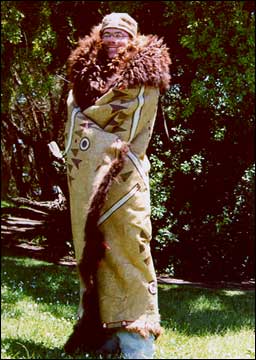

With this article, I am picking out one small element of the complex interrelationship of native people and their environment and what can be learned from it today. I would like to honor the Buffalo Nation and all our non-human relatives, whose lives we take to sustain ourselves, and maybe help to reevaluate the way we use our resources, especially when a life has been spent for them. The buffalo is one good example of this tragic process; a creature that has been exploited to its almost complete destruction. Even today this tragedy is continuing to a certain degree in Yellowstone National Park, home of the last wild and unfenced buffalo herd in the USA. For information check www.wildrockies.org/Buffalo.
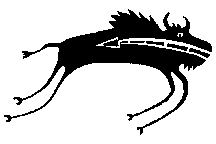
| Image to the left: Dakota Sioux pictograph
of a buffalo. Image to the right: Petroglyph from Saskatchewan, Canada. |
The article will describe the art of tanning raw bison hides into robe size hides with the hair left intact; similar to the way as practiced by the women of many Native American tribes on a large scale, until the end of the 19th century. It will be a step by step description of the work process and also the use of bison hides, including quotations and observations made by early travelers and pioneers amongst native tribes of the 18th and 19th century.
I still remember a drawing I made when I was a kid back in Germany. It was a self-portrait of me dressed in leather with a fur cap on my head and a rifle in my hand. I presented it in school and explained that I wanted to be a trapper when I grew up. The teacher laughed and said that all little boys liked cowboys and Indians and that those feelings would disappear, as we grew older. I was very angry with her. The underlying fascination of the powerful buffalo, that shaggy beast, that in our modern world looks like a relict of times long gone by, stayed with me for all those years.
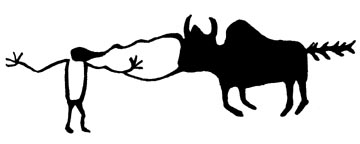 My first encounter
with live buffalo was a rather unimpressive one. In my early twenties,
I traveled to New York and went to visit a friend in Buffalo,
NY. After arriving at the train station at night, he drove me
to the local zoo to see the namesakes of his town. There they
were, in a small enclosure, sadly staring from the dark into the
headlights of our truck. Today I live in San Francisco and am
fortunate to have a small herd of bison close by. They live in
Golden Gate Park in the middle of the city (for info check the
site: www.bwfly.com/watchbison
). I got my first real piece of buffalo from those animals
in the form of shed winter hair that I collected when I was volunteering
to help clean up the paddock. Then one day I ran across the address
of Jim Miller of Michigan, the first man I heard of, who was brain-tanning
buffalo hides and teaching classes too. When I called him, he
said I need not apply for class until I had tanned at least a
half dozen deerskins and a bunch of pelts. Therefore, a few years
later after I had accomplished that, I traveled to Michigan in
January and was fortunate enough to have a one on one class with
him. (call Jim at "Willow Winds" 515 736 3487 for information
on his classes or a copy of his booklet "Braintanned Buffalo
Robes, Skins and Pelts")
My first encounter
with live buffalo was a rather unimpressive one. In my early twenties,
I traveled to New York and went to visit a friend in Buffalo,
NY. After arriving at the train station at night, he drove me
to the local zoo to see the namesakes of his town. There they
were, in a small enclosure, sadly staring from the dark into the
headlights of our truck. Today I live in San Francisco and am
fortunate to have a small herd of bison close by. They live in
Golden Gate Park in the middle of the city (for info check the
site: www.bwfly.com/watchbison
). I got my first real piece of buffalo from those animals
in the form of shed winter hair that I collected when I was volunteering
to help clean up the paddock. Then one day I ran across the address
of Jim Miller of Michigan, the first man I heard of, who was brain-tanning
buffalo hides and teaching classes too. When I called him, he
said I need not apply for class until I had tanned at least a
half dozen deerskins and a bunch of pelts. Therefore, a few years
later after I had accomplished that, I traveled to Michigan in
January and was fortunate enough to have a one on one class with
him. (call Jim at "Willow Winds" 515 736 3487 for information
on his classes or a copy of his booklet "Braintanned Buffalo
Robes, Skins and Pelts")
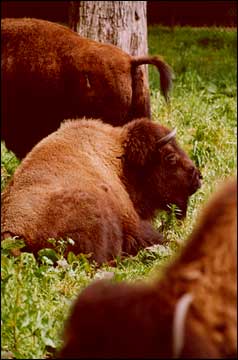
About Braintanned Buffalo Robes
Braintanning is not a strictly Native American art, but was
practiced in many parts of the world throughout human history.
For example, the Iceman from Italy wore braintanned skins. ("Der
Mann aus dem Eis "by Angelika Flechinger and Hubert Steiner,
also "Leather" by Lotha Rahme on European tanning tradition)
Unlike modern day commercial tanning, braintanning is an environmentally
safe way of tanning that does not use or produce any toxins or
chemicals.
These tanned buffalo hides had a multitude of uses for native
people. They were used as bedding, for example among the Kiowa
as described by J.J. Methvin: "When a boy or girl grows up
to sufficient size or age, a Pa-lo-tle-ton is set apart for his
or her exclusive use. This is a buffalo robe, neatly dressed,
made of a full skin, with the head fastened by the lips to the
heads of their lounge- like, willow beds. The On-ta-koi is the
ordinary robe for the bed. It is only a half robe, and cut off
also at the neck. The hide of the Pa-lo-tle-ton is carefully taken
off, with all the skill of the taxidermist, so as to preserve
its full covering of the head, with even the horns and eyes and
ears and lips, and also the legs down to the hoofs, and sometimes
even the hoofs are retained."
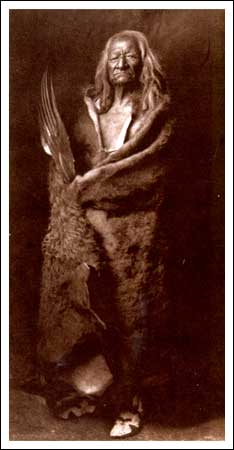
| Black Eagle (Assiniboin), 1908 As the last wild buffalo herds got wiped out in the early 1880s, we can assume that the robe, worn by the man in this photo, was at least 25 to 30 years old at the time his picture was taken. Photo courtesy of AZUSA Publishing |
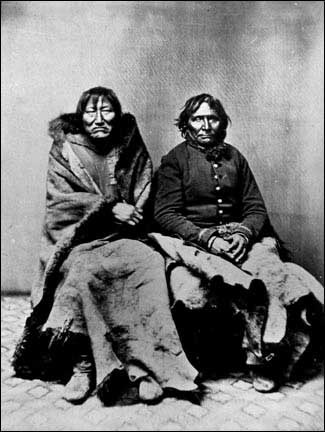
| Comanche leaders (1863.) wearing traditional
buffalo robes over European style clothing. This interesting
photo is a very good source for studying the degree of pliability
and softness achieved in buffalo robes. Additionaly two staking/lacing
holes can be seen on the bottom of the left robe . Photo courtesy of British Museum (negative # MM034564-25) |
E-mail your comments to "Markus Klek" at markusklek@yahoo.com.
Markus Klek resides in Germany.
We hope the information on the PrimitiveWays website is both instructional and enjoyable. Understand that no warranty or guarantee is included. We expect adults to act responsibly and children to be supervised by a responsible adult. If you use the information on this site to create your own projects or if you try techniques described on PrimitiveWays, behave in accordance with applicable laws, and think about the sustainability of natural resources. Using tools or techniques described on PrimitiveWays can be dangerous with exposure to heavy, sharp or pointed objects, fire, stone tools and hazards present in outdoor settings. Without proper care and caution, or if done incorrectly, there is a risk of property damage, personal injury or even death. So, be advised: Anyone using any information provided on the PrimitiveWays website assumes responsibility for using proper care and caution to protect property, the life, health and safety of himself or herself and all others. He or she expressly assumes all risk of harm or damage to all persons or property proximately caused by the use of this information.
© PrimitiveWays 2013